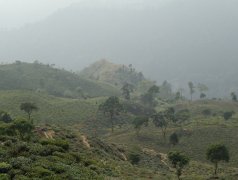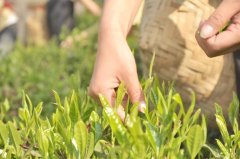Flow chart of how to make Darjeeling black tea from India, the three famous black tea brands in the world.
Darjeeling, translated from Tibetan, which means "land of thunder and lightning", is a priceless gem of a town in the lower Himalayas. Darjeeling's history seems to begin with a station built on the mountain by the British East India Company (British East India Company) in 1835. Until then, the region had been under the rule of the Sikkim rulers. After reaching an agreement with the company, the rulers of Sikkim allowed them to build sanatoriums for soldiers. Once the British took control of the area, the era of planned development began, and a new mountain station appeared in the form of Darjeeling. Darjeeling has always been known as the queen of the mountains. It is not hard to see why-green hills, tea gardens, UNESCO-approved toy trains and smiling Gurkha-have always been part of the Darjeeling legend. Darjeeling, once a bustling place of entertainment for British people, is now crowded with family holidaymakers and adventurous travelers seeking leisure. In the east, a dark orange sun appeared, and brilliant pens of red, gold, orange and fuchsia painted the sky. Snow-covered Mount Everest, Cabru, Gancheng Jung, Janu and other peaks slowly wake up from their slumber to start a new day. People who worship the sun gasped at the spectacular sight. As the fog slowly cleared in the sun, the town gradually came to life. In the process of making tea, the local dialect "Gurkali" rises and falls like music. The art of Yuqing the method of picking Darjeeling tea is as unique as its taste. Great emphasis is placed on picking methods, because the real quality is inherent in good raw materials (tea), and the special Darjeeling flavor is produced by very fine picking standards. The smallest bud consists of two leaves and a bud. It needs 22000 buds, all of which are picked by hand to produce 1 kilogram of tea. To achieve such a high green standard, the hilly terrain makes the task more difficult. Over the years, Darjeeling tea pickers have been struggling with difficult terrain, cold, fog and rain to maintain strict standards. They start early in the morning, when the dew still exists at night. Only the tenderest leaves are carefully picked by gentle hands. Young people are so fast and skilled that it is often impossible to track the movement of their hands and fingers.

In this process, the green leaves are spread evenly on the trough, blowing out hot and cold air regularly. The goal is to slowly remove moisture from the leaves within 14-16 hours. Twist the dead leaves into the twist and twist them mechanically. This process is carefully monitored so that the pattern of the leaves remains the same and does not overheat. After oxidative fermentation is rolled, the leaves are spread on a very thin layer in a cool, damp room. The whole process lasts 2-4 hours, depending on temperature, humidity and the quality of the leaves. In this process, tea has formed a unique flavor and aroma. The sensory judgment of the tea maker is very important to the quality of tea brewing. The dried and fermented tea is taken to the dryer, where it is regulated at different temperatures for 20-30 minutes. As a result, black tea loses moisture after natural fermentation. Finishing and packaging this is the final stage, where tea is graded according to size and packed in specially designed foil-lined packaging. Tasting Darjeeling tea is an elegant art, it must contain many variables. Tasters are very sensitive to taste and smell, and have a high degree of discrimination. Experienced tea tasters can identify the tea gardens and environmental conditions on the picking day, and can even suggest adjustments in the production process. The tea taster uses his keen sense of sight, smell, touch and taste to judge the quality of tea. When evaluating tea, tea tasters must also have an in-depth understanding of the current market situation, consumer preferences and production processes. These are natural gifts-it can be said that wine tasters are born, not nurtured. However, these talents must be trained and developed over the years to make taste skillful enough to recognize subtle differences. This is especially true for Darjeeling tea tasters because the quality of tea varies from invoice to invoice, and as an exclusive tea, there is no standard to measure it.
Important Notice :
前街咖啡 FrontStreet Coffee has moved to new addredd:
FrontStreet Coffee Address: 315,Donghua East Road,GuangZhou
Tel:020 38364473
- Prev

Where does Darjeeling Tea come from? The Historical Story of Darjeeling Black Tea in India
What is Darjeeling Tea? according to the Indian Tea Committee, what Darjeeling Tea means is: tea planted, planted, produced, manufactured and processed in tea gardens in the hilly areas of the Sadar subzone (see annex for the current schedule), only in the hilly areas of the Kalimpong subzone, including samabon
- Next

What kind of tea do you drink to calm the mind and help you sleep best? what kind of tea can improve your sleep? which kind of tea is most likely to cause insomnia?
Tea and sleep tea contribute to sleep or harmful to sleep? The tea in Camelliasinensis contains caffeine, a stimulant known to interfere with sleep. However, the caffeine content of tea is significantly lower than that of coffee, and tea contains chemicals other than caffeine.
Related
- The milk tea cup becomes smaller?! Overlord Tea Girl launches a new "Return to Yunnan" series
- Accused of selling counterfeit and high-priced coffee beans! Well-known boutique coffee brand "Oukelao" bowed and apologized!
- How to make espresso dumplings? Can I eat coffee and glutinous rice balls together?
- Save the unformed and stagnant powder cakes in one second! What is the problem with stagnant water in the powder bowl of the espresso machine?
- What does hand-brewed coffee stop mean? Why is it not recommended to make coffee by hand?
- Is it normal to smell like coffee? Why does coffee smell like alcohol? What's wrong with the strong smell of cold extract ice dripping ice brewed coffee?
- How to solve the problem that hand-brewed coffee extraction takes too long? Why is the water flowing so slowly when making coffee?
- The main points of making Australian white coffee, the proportion details, how does Australian white properly foam and blend the flowers?
- Can ice water make cold extract coffee? What is the difference between room temperature water and ice water for making cold coffee?
- What milk is best for making latte and white Dirty coffee? What is the difference between different brands of fresh milk and pure milk for making coffee?

